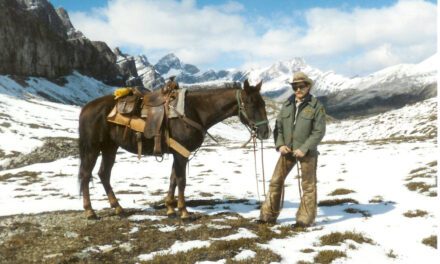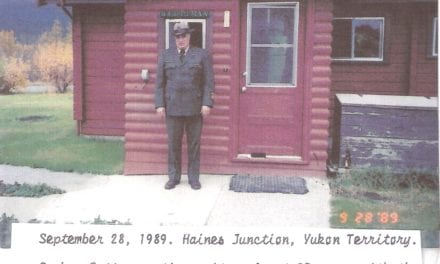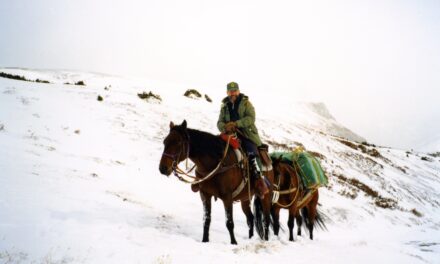(52:29) One of my other memorable stories was dealing with a mauling in 1984. I can’t remember the name of the fellow that got mauled near Crypt Lake. I think it was Kevin Van Tighem’s (former Superintendent of Banff National Park) sister that (also got mauled). I was involved with that. It was myself, Keith Brady, Randall Schwanke, and Dr. Herrero came up the following day. Randall and I were the first two on the scene. That story starts at home. I got a call from the boat tour company requiring an ambulance. Myself and Max Winkler go over to the dock area there and in the shelter was the fellow who had been mauled severely…I can still picture him in my head, how badly he was mauled. The tour operator had gone back for his partner/girlfriend. I believe it was Kevin’s sister. She was being delayed on the trail; she wasn’t able to move as quick. We got those two into Cardston to the hospital and then Randall and I went up to see if there was anybody else in there and recover anything. It was dark and it was snowing. It was early September and you couldn’t see 50 feet in front of you. Knowing there was a bear out there…not knowing if it was a black bear or a grizzly or what…We had no way of knowing that time because those people didn’t see the bear coming. It wasn’t until later on, say an hour after we arrived and found out there was no one else there and found out where the incident occurred, there were some packs on the ground. We secured the area and didn’t see any bear and we didn’t see any sign because it had snowed so heavily. A crew came up behind, they had some snare traps and some bait. We set a couple of snares and it wasn’t until the next day when we went back and it had stopped snowing that you could see…there was a sow and a couple of yearling grizzly cubs involved with that incident. Oh, Earl Wilson was the other fellow who was with me and Keith Brady. Randall was up with Dr. Herrero measuring how far up the tree Kevin’s sister had climbed before the bear climbed it and knocked her out. We had been scouting around and we found a dead ewe and surmised that either the bear was coming in onto the carcass or coming off the carcass when those two hikers went right by. We could hear her woofing when we first arrived, but after a while it seemed like she moved on, or she quieted down anyways. She wasn’t disturbed by us being there. There were three of us gathered around, Keith, myself and Earl when all of a sudden, Keith says, “Here she comes!” And she charged us. Luckily Keith had a good clear shot. I had a shot, but Keith had already put the bear down with his first shot. Anyways I think it was nine paces away from us where she went down, so we were quite relieved! There is a lot more to that story as you well know, but that’s the basics. Those kinds of things you do remember in your career and other rescue work and so on.
(56:53) Myself, Lloyd and Ron Chambers received an honoraria testimonial from the Royal Canadian Humane Society for a rescue off Mount Logan in Kluane in 1977. It was a high altitude rescue, the first of its kind I think in Canada. It was such a technical thing, not technical in terms of ropes or chalk and all those kinds of things, but technical in terms of the altitude.
How did the Warden Service change over the years?
(57:56) Oh boy! The first example I gave is when I went north and then I left the warden service and came back and all of a sudden, I quickly realized our role in law enforcement had changed from one of maybe going to a campground to deal with a bear situation or advising campers you had an extreme fire hazard, ensuring people didn’t have fires and so on, to one of simply dealing with rowdies and alcohol. We didn’t have the authority under the liquor laws to deal with it, but that is when things began to change. Of course there was an expectation by superintendents in those days because we were the only ones with authority in Parks in law enforcement, there was an expectation that we would do it. Do the job, although we clearly didn’t have the legal power to do it. It was all a bluff I guess is the best way to describe it. As the years progressed along we began to train up and acquire the correct authority, we staffed differently. We were looking for people with some kind of law background. So that was one of the changes.
“Did you think that was a good thing or a necessary thing?”
(59:14) The other change of course was the functionalizing into specialties, public safety, law enforcement, resource management. Clearly that was quite a role change… When you specialize into doing environmental assessment, I can do an environmental assessment and I had two years of tech school and I could rely on experts to provide me with advice whether they were in the regional office or at university or so on. As long as you had the wherewithal to go and contact these people, but we began staffing for specialties. I worked avalanche control in Banff during the wintertime, at Sunshine then at Norquay. Clearly I didn’t have the expertise to begin with. I could ski, but I acquired that expertise by working there, two years wasn’t long enough. But I guess the best way to describe it is for the most part, people who didn’t possess those specialties became very important team players during rescue work.
(1:01:17) I think the biggest change for me in the warden service was at the end dealing with law enforcement and the arming issue.
(In 2000, Banff warden, Douglas Martin filed a federal Labor Code Complaint arguing that, without a side arm, he was being placed in situations of potential danger without the necessary protective equipment. (Remington, Robert. “Men for the Mountains.” Discovering Alberta – A Calgary Herald Magazine Series). After seven years of discussions and appeals, the National Occupational Health and Safety Policy Committee recommended that Parks Canada give wardens side arms. However, wardens were later relieved of their law-enforcement duties, with the exception of enforcing federal conservation laws. “In 2008, the union complained wardens could be mistaken for police officers because of their uniform and cars and that they were still unable to protect themselves. Parks Canada has since ruled that wardens will dress like any other park employees and 100 armed-enforcement officers were hired. These 100 officers are now the only employees with the warden title and uniform. They are in charge of protecting Canada’s 41 national parks and park reserves.” (Agrell, Siri. “Park Wardens Out of Uniform: From Stetsons to Ball Caps” Globe and Mail. June 7, 2008.).
That was clearly a game changer. Other than being a separate ecosystem secretariat, the wardens in uniform probably possessed as much expertise and knowledge as a biologist might. Those roles still function very well together. But when the arming issue became prevalent, it really changed. Of course some wardens were pro arming and some were against arming. Generally it came down to where you were at within the warden service, whether you were performing a law enforcement role, or a resource management role, or a public safety role and the type of park you worked in. For instance, when I was in the Saint Lawrence Islands a lot of work in the summer, you couldn’t enter the park without being in a law enforcement role. You were in uniform, you entered a dock and immediately you were in a law enforcement role. Visitors were expected to register for docking, there were a lot of other things that were going on, dogs off leash etc, etc and that was just to get to the pond that maybe you wanted to go to do some herptile work on. You were clearly in a law enforcement role initially whereas maybe in Banff, Jasper, Waterton or Pacific Rim, you weren’t in those roles. So it depended on where you were.
“Are there any characters from the service that really stick out in your mind?”
(1:03:38) I guess the characters… Mac Elder, whose house we are in now! I was working with Mac at Maligne and there was an extreme fire hazard. Of course when there is an extreme fire hazard you know no fires are permitted…We were down at Medicine Lake and there is a small day use area on the south end of the lake, on the upper end of Medicine Lake and we drive up. We were working together and there was a group who had an open fire. Of course they saw two wardens driving up and they were pretty pleased…they say, “Hi, how are you doing?” And so on, “What’s up?” I was closest to them and I got out of the truck and I saw Mac go behind and reach into the box of the truck and he pulls out a canvas water pail and loads it up with some water down by the creek. These guys around this fire are trying to form up a conversation and Mac slowly walks over and throws water on the fire and douses the whole atmosphere! I thought it was pretty funny! They didn’t think it was funny at all.
(1:05:16) Another funny one, it was a snowstorm and I was working in Banff. Scott Ward and I were on a patrol…we were in a warden vehicle and there was somebody just off the shoulder, not really into the ditch, but off into the heavy snow. The guy realized that we were an emergency vehicle of some sort and flags us down. Scott was driving and he (the guy) says, “Can you call me a tow truck?” So Scott says, “All right, you are a tow truck!” He rolled up the window and made like he was going to drive away, but we didn’t!
“Is there anything about the warden service that you would want future generations to know?”
(1:07:04) I go back to my very beginning and the feeling. I don’t know if it is the same anymore, I can’t say that it is, the feeling I had for the type of work. I only joined at the end of the district system. I had an opportunity to work it briefly and I think of the guys that were before me, Keith Foster, Mac Elder, Toni Klettl, those who lived out in the backcountry districts for years in some cases with their families, taught their children when they were living in the backcountry. You know we could do all that today because we have wonderful communication systems, yet we don’t. We live in towns and small cities now. To me it was a way of life. That is actually what I would want to tell young people, that it was a real way of life. You lived it, you worked it and your friendships were all developed through your work. You were all like minded. I am sure that they are now still. But because I have experienced the district system, the area system, the function system to the integration of different services, it’s just different. It is a different feeling. I would hope that somehow we will go back to a portion of it…It makes sense to me because as I alluded to we do have the communication systems in place. A lot of the reasons we centralized into area systems was to be able to bring families out of the wilderness into the 20th century at that time. I’ve talked to many people from other services, like for instance, a good friend of mine who is a little older than I am, he retired from the Alberta Forest Service, he had the same feeling having worked on ranger stations in the foothills. He has the same feeling that people now are dependent on their trucks and their computers and they probably spend 90% of their time indoors, whereas perhaps it used to be you would spend 95% of your time outdoors. So it is that feeling, that way of life.
What made the warden service such a unique organization?”
(1:10:53) You were a group of individuals, you visited, you partied together and the time off you had was spent together. There was a great camaraderie.
(1:11:18) When you talk about some of the changes, one of the changes of course was the first women in the warden service. It wasn’t an impact on the work at all, it was an impact not even on family life, it was more the thought of what impacts there might be and of course there weren’t any…The first time I met Kathy. (Kathy Calvert was hired in 1974 as one of the first female wardens in Canada). Now she had probably come on the service before hand, she was on a climb in Kluane with a group of other ladies. (Kathy was a female pioneer for the warden service, as well as for the mountaineering community. She was part of the first all women’s expedition to Mount Logan and the original all women’s ski traverse from the Bugaboos to Rogers Pass.) I was up there as one of the wardens…
“Do you have any lasting memories as a warden, a favorite park or cabin etc?”
(1:12:50) A favorite cabin was Cairn Pass in Jasper because of its location. My favorite park as I mentioned earlier was Kluane. My best friends are through the warden service, even still today.
“Do you ever miss being a warden?”
(1:13:41) Sometimes not because of the goings on nowadays in terms of law enforcement and the downsizing and how it is being implemented, but my lasting impressions are yes, it was a great dream and I had a great experience and I couldn’t have wished for a better job.
“Is there anything I haven’t asked that you would like to add?”
(1:14:44) Because I have been around to so many national parks there are so many stories I could tell, it is just hard to pick one or two to even begin to talk about things!
“I should also ask what you do now in retirement?”
(1:15:29) We travel and we visit. Every year we have been going to Arizona. This will be our seventh or eighth winter in Arizona. We only go from six weeks to three months. I work part time. I am too addicted to money! In Black Diamond there is a Rona store and I work three days a week there. I worked two summers at a golf course, cutting grass. That was kind of a different job. I often wondered what those fellows did in national parks at the golf courses. Now I know! I have been working part time and I will probably do one more year.
(1:16:24) We don’t go to national parks as much as we used to. One of the other changes I didn’t talk about was the revenue. The need for revenue, it really changed a lot of things, marketing being one, budgeting allocations, trying to get more money so that you can get above your budget allocation and reinvest that money into parks. It was just a vicious circle. I think that we have overpriced a lot of people who could go to national parks aren’t going because they can’t afford to…We buy a seasonal pass, a Canada pass for all parks because our son lives over on the west coast of Vancouver Island in Pacific Rim, he doesn’t work there, but we visit that park annually.
(1:17:39) The other thing I should add is I now have a nephew who is, I don’t know what you call it, a park warden or whatever. He is in Sirmilik National Park, on the north end of Baffin Island, in the Pond Inlet area. He’s been with Parks Canada for six years now. He just finally got his permanent job here recently. He is another Harbidge, so the name will be around for a few more years!
“You have a son and a daughter?”)
(1:18:14) I have a son and a daughter. My daughter lives in Kamloops and my son lives in Ucluelet. I also have two other boys who are from my wife’s first marriage, but they are like sons. One lives in Toronto and the other lives in Creston.
“Any grandchildren?”
Yeah seven!) Did I say seven, make that eight. It is eight now.
“Do you see them often?”
Not as often as one would like. One family group was here for Christmas and one is out east in Toronto. Normally what we do when we go to do our rounds is we go to Kamloops and stay there and come back through Highway Three and stop in Creston and stay there.

Warden Friends, Mac and Kathy Elder, Rod Wallace and Sharon Wood, Larry and Sharon Harbidge.
December 28, 2012 in Cochrane Alberta



